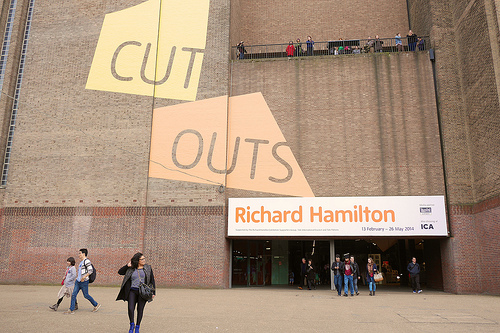Richard Hamilton – Pop Art Heavyweight at the Tate Modern
Richard Hamilton is one of the least known of the Pop Art heavyweights, yet was one of the most influential. Most people have heard of Andy Warhol and Francis Bacon, but few have heard of Richard Hamilton, despite the fact that he was one of the founding fathers of the Pop Art movement. The Tate intends to rectify this blind spot in the public consciousness by holding a major retrospective of Hamilton’s work from the early 1950s until his death in 2011.

The exhibition at the Tate Modern began on 13 February and will end on 26 May. Tickets are available online (for a small surcharge) or from the ticket office at the museum. Don’t forget, however, that if you are a Friend of the Tate you can enjoy free entry to this and other exhibitions held throughout the year.
The Life and Times of Richard Hamilton
Richard Hamilton was considered to be one of the most daring of his compatriots. Unlike Andy Warhol, his work was far more than a superficial representation of celebrity icons. His work encompassed celebrity culture, politics and technology and throughout his artistic career he continually stayed one step ahead of his fellow artists, experimenting with a wide range of different materials and styles.
Pop Art Collage
One of Hamilton’s era-defining works from the early days of the Pop Art movement was ‘Just What Is It That Makes Today’s Homes So Different, So Appealing?’ The original piece is much too fragile to be exhibited, so you will have to make do with a print. It features a depiction of Adam and Eve in a cluttered living room, which is intended to be a modernist Garden of Eden.
Political Commentary
Hamilton was very interested in the political machinations of the period, something that didn’t change as time went on. In an installation from the 1980s, Hamilton placed a video monitor playing a Margaret Thatcher speech on an endless loop, above a hospital bed. The work was entitled ‘The Treatment Room’. He also depicted Tony Blair as a gunslinger in one of his later works.
Scatology
Hamilton had an enduring fascination with poo. A whole series of works from the early 1970s featured pretty still-life compositions, scenic landscapes and colourful sunsets, which at first glance appear to be fairly innocuous, but when you look closer you will see small toilet rolls and piles of poo. As others have commented, Hamilton was always happy to cause a stink with his art.
Indeed, one of his best-known works features both politics and poo. The Citizen, referred to as a ‘strange image of human dignity in the midst of self-created squalor’, was a diptych completed in 1983. The subject matter was an IRA prisoner undertaking a ‘dirty protest’ in the Maze Prison. One panel shows the prisoner wrapped in a blanket with a brooding expression on his face, and the other a faeces smeared wall.
The work of Richard Hamilton is an attack on all five senses, and is at times deeply unsettling. But the Tate retrospective is fascinating, absorbing and always compelling, so definitely not one to miss.

